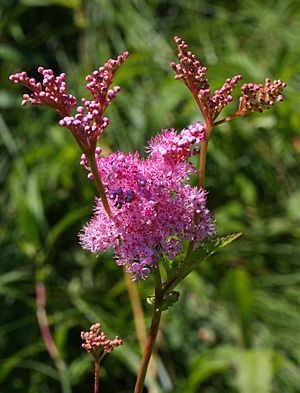Queen-of-the-prairie facts for kids
Quick facts for kids Queen-of-the-prairie |
|
|---|---|
 |
|
| Filipendula rubra flowers | |
| Scientific classification | |
| Synonyms | |
|
Filipendula rubra, also known as queen-of-the-prairie, is a beautiful species of flowering plant. It belongs to the rose family, Rosaceae. This plant naturally grows in the northeastern and central United States, and southeastern Canada.
The queen-of-the-prairie likes lots of sun or a little shade. It also prefers wet soil, but it can handle drier soil if it's in a shadier spot. This plant grows tall and strong. It produces tiny, pink flowers above its fern-like, pointy leaves. One special type, called 'Venusta', has even won an award for being a great garden plant!
Contents
Where Queen-of-the-Prairie Grows
This plant is originally from areas like Pennsylvania, Illinois, and north of Georgia. However, you can also find F. rubra in places like Massachusetts. It was first seen there in 1875 and still grows there today.
In many places where it naturally grows, like Indiana, F. rubra is now a threatened species. This means it's becoming rare. Its favorite home is in wet areas called wetlands, especially special kinds of wetlands called calcareous fens. You might also find it near springs or in wet prairies. Because these fens are rare, the groups of F. rubra plants are usually small and far apart.
What Queen-of-the-Prairie Looks Like
The queen-of-the-prairie is a herbaceous perennial. This means it's a plant that lives for many years and doesn't have a woody stem. It can grow very tall, from about 1.8 to 2.5 meters (6 to 8 feet) high. It can also spread out to about 1.2 meters (4 feet) wide.
It has large, lobed leaves and red stems that branch out. In the summer, it produces clusters of deep pink or peach-colored flowers. These flowers have a sweet smell. A single plant can have hundreds or even thousands of small pink flowers. The flowers have many stamens, which are the parts that make pollen. These stamens make the flower look fuzzy. Each flower has several small parts called carpels and pistils. The plant's leaves are a medium to dark green and have a rough texture.
How Queen-of-the-Prairie Reproduces
Filipendula rubra is known for its pollen, which can travel through the air. However, for the plant to make seeds, its pollen must come from a different F. rubra plant. This is because the plant cannot fertilize itself; it is self-incompatible. Most of the pollen from one plant will not be able to create seeds on that same plant. Insects like sweat bees help by carrying pollen from one plant to another.
The plant also spreads aggressively using its creeping roots. These roots grow underground and help the plant form large clumps.
Why Queen-of-the-Prairie is Endangered
The Filipendula rubra plant is considered an endangered species by the USDA in several states. These include Illinois, Maryland, New Jersey, and North Carolina. It is also considered threatened in Iowa and Michigan.
What Causes Endangerment
The main reasons F. rubra is endangered are not because animals eat it or because of plant diseases. Instead, it's mostly due to its difficulty with pollination. As mentioned before, it needs pollen from a different plant to make seeds. This process is harder than for many other plants.
Another big reason for its endangerment is habitat loss. Many of the wetlands where F. rubra naturally grows are disappearing. This is often due to human development.
Uses of Queen-of-the-Prairie
Native Americans traditionally used the root of F. rubra as medicine. They used it to help with heart problems. The root has a lot of a substance called tannin. This makes it useful for treating issues like diarrhea, dysentery, and bleeding.
People also use this plant in gardens because its flowers are pretty and smell nice, like lilac. You can find it in some plant nurseries, but it's still not very common in most American gardens. The 'Venusta' type is the most popular, with bright rose-pink flowers.
This plant grows well in full sun or partial shade. It needs soil that is moist or even wet, as it doesn't do well in dry conditions. Its maple-like leaves appear early in the spring. It spreads using underground stems called rhizomes, forming a large clump over time. If it gets too big, you can easily dig it up and replant it. It can also self-sow, meaning its seeds grow into new plants in the garden. If the plant looks unhealthy due to drought, you can trim it back, and it will often grow new, healthier parts.
While humans find F. rubra beautiful, it doesn't offer much to wildlife. For example, it's not a host plant for butterflies or moths, meaning their caterpillars don't eat its leaves. It also doesn't produce any nectar, which is a sweet liquid that many insects drink. Even though its bright pink flowers usually attract butterflies, they won't find any nectar there.
This plant competes for wetland space with other plants that support more wildlife. Also, its seeds are not a major food source for birds or small animals. Most plant-eating animals don't like to eat its leaves. Its flowers do provide pollen for insects that eat pollen. However, some experts say the plant mostly relies on wind for pollination. This means less pollen is available for insects to eat. Because of this, some conservationists suggest using this plant mainly for looks in gardens. For restoring natural habitats, they recommend focusing on other plant species that help more wildlife.
See also
 In Spanish: Filipendula rubra para niños
In Spanish: Filipendula rubra para niños

